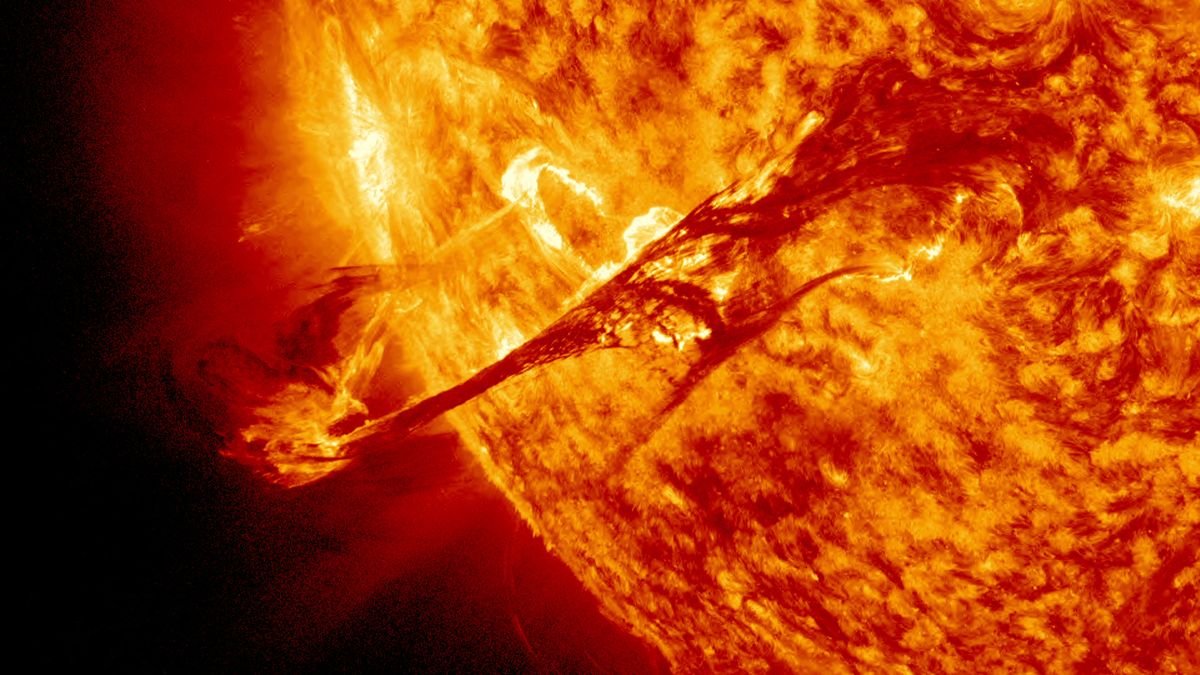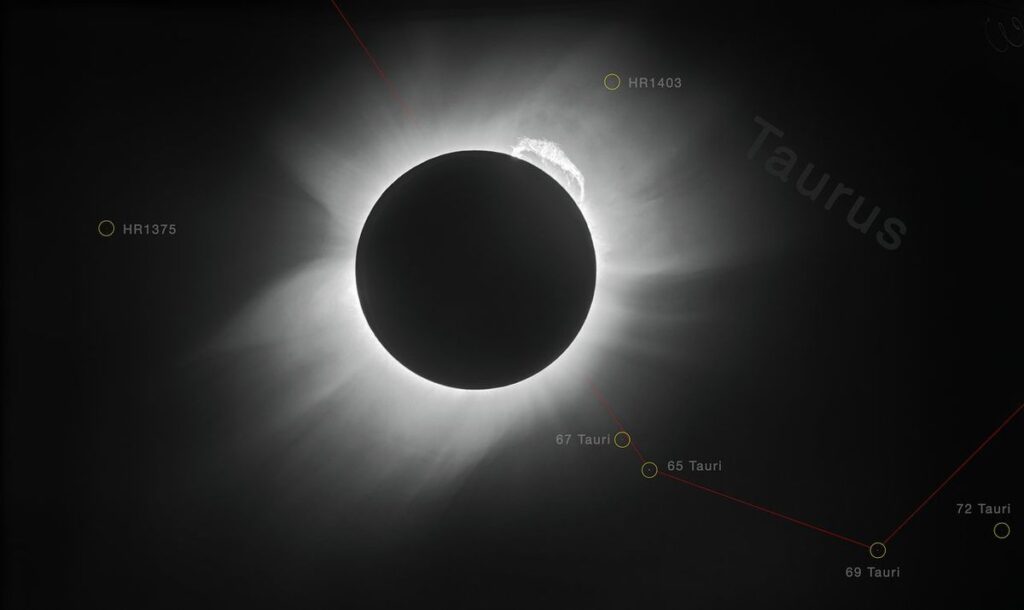If you find yourself in the direct path of the April 8 total solar eclipse, you will witness a momentary plunge into darkness — known as totality — lasting from a few seconds to a couple of minutes. This moment marks the only time it is safe to gaze directly at the sun without the protection of solar eclipse glasses. During this phase, if you look towards the sun’s corona, you might observe dark-pink formations, resembling towers and loops of electrically charged plasma extending far beyond the Earth’s diameter into space. These features, known as “prominences,” were notably magnificent and extensive during the previous total solar eclipse in Australia on April 20, 2023.
It’s highly likely that these prominences will be visible again during the total eclipse in North America on April 8, especially since the sun is expected to be at the solar maximum, the peak of its 11-year activity cycle.
Coronal Mass Ejection
Although prominences can be seen for several days using a hydrogen alpha telescope at any time, the total eclipse offers the opportunity to witness other unique solar phenomena. Among these is the coronal mass ejection (CME), a rare event that might be observable during totality.

“A coronal mass ejection, if we’re fortunate, will appear as a contorted, spiral formation, situated high in the sun’s atmosphere,” explained Ryan French, a solar physicist at the National Solar Observatory in Boulder, Colorado, and author of “The Sun: Beginner’s Guide to Our Local Star (Collins, 2023),” in a conversation with Space.com. A CME involves a massive burst of the sun’s magnetic field and plasma from its corona, moving swiftly but appearing motionless over the span of a few hours.
Solar Flares
“This means,” French continued, “that the same solar event could be observed from different locations, such as Rochester and Dallas, each witnessing different phases of the prolonged eruption.”
The moon’s shadow will traverse North America in 100 minutes, providing a unique opportunity for a coronal mass ejection (CME) to occur just before the eclipse, making it potentially visible to all under clear skies.
CMEs are not strangers to the phenomenon of totality. For instance, one was captured during the “Great Patagonian Eclipse” on December 14, 2020, in Chile, a period when the sun was nearing its solar minimum. In addition to CMEs, solar flares are another solar activity to look out for. These are intense bursts of energy emitting radio waves, visible light, X-rays, and gamma rays from the sun’s surface, reaching Earth in just eight minutes as they travel at the speed of light, often occurring after a CME.

Despite the occurrence of three X-class solar flares — the most intense category — in a single week in February, it’s improbable to witness one during the total eclipse.
“Solar flares differ from CMEs as they originate much lower in the sun’s atmosphere, near the lunar edge, and are visible for only a brief period,” explained French. “They could appear as red loops near the sun’s surface, resembling low-altitude prominences.”
However, for a solar flare or a CME to be visible during totality from Earth, its positioning above the sun’s limb is crucial, ensuring it’s not obscured by the moon during those fleeting moments of totality, French noted.
Giant Eruptive Prominences
On April 8, during the total eclipse, we can expect to observe prominences, according to French. He explained that prominences vary significantly in size and are more frequently seen when the sun is at the peak of its activity cycle, known as the solar maximum. Occasionally, these prominences burst forth, breaking away from the sun’s surface and spreading out into the solar system.
Such an event would be an incredible spectacle. However, what those who follow eclipses fervently hope to witness are the “giant eruptive” prominences, particularly those that detach from the sun’s surface and drift independently in the corona.

French noted that there have been several instances of such dramatic prominence eruptions in recent months, each capable of providing an exceptional spectacle if it had coincided with a total solar eclipse. Nonetheless, he pointed out that the eclipse will offer a chance to see stationary, non-eruptive prominences as well. Although these will be smaller and located closer to the sun’s surface compared to their more dramatic, mid-eruption counterparts, they will still contribute to the awe-inspiring experience of totality.
Extending Total To View More Eruptions
“The challenge with eclipses is their brief duration, limiting the opportunity to take extended measurements,” Amir Caspi, chief scientist at the Southwest Research Institute in Boulder, Colorado, shared with Space.com. He noted the sun’s fast-paced nature, with events like solar flares or coronal mass ejections (CMEs) unfolding in mere minutes or seconds.
Due to the short window of totality and the low probability of witnessing such rapid solar events during this time, Caspi mentioned there’s essentially only one workaround: prolonging the duration of totality. One historical method involved flying in a supersonic jet, such as the Concorde in 1973, which extended totality to 73 minutes by chasing the moon’s shadow.

An alternative strategy is to record the eclipse across a wide area, hoping to capture the start or finish of these swift solar phenomena. While this is a rare outcome, it’s expected to occur on April 8. On this day, the total eclipse will start in Texas at 1:27 p.m. CDT and conclude in Maine at 3:35 p.m. EDT, spanning 68 minutes across the U.S.
Caspi is spearheading the Citizen Continental-America Telescopic Eclipse (CATE 2024) project, aiming to create a continuous 60-minute 3D film of the sun’s corona in polarized light. This ambitious project will involve 35 teams of three to four amateur scientists each, employing standardized camera equipment and hoping to capture remarkable solar activity.









